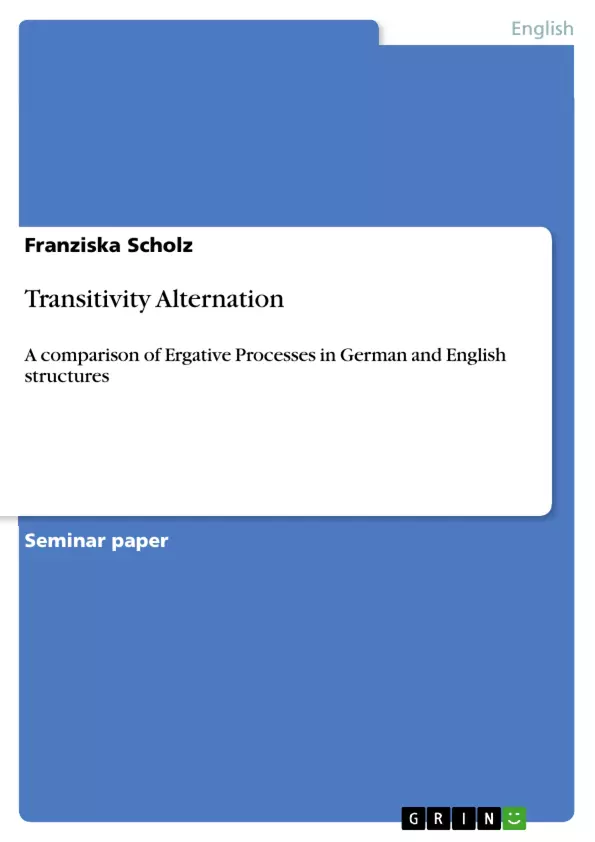The English grammar has many similarities with the grammar of German, since both have their roots in the Germanic languages. Therefore English and German share lexical and structural, but also semantic properties. In order to deepen one’s understanding of these properties this paper will deal with differences and similarities of the English and German verb system.
Transitivity alternation is based on the syntactic distinction of verbs that are divided into transtive and intransitive verbs. This paper deals with both verb categories, taking into account semantic matters as well. In English and in German a verb can express the way in which an action affects its object, which is part of the so-called ergative model. This model shall be introduced in Chapter 2 with examples of the English language. After the introduction to the usage of ergative verbs a comparison of English and German structures follows in Chapter 3. Mistakes of translation are often due to structural and semantic differences within the ergative model. English and German verbs do not always provide the same variety of possibilities to express an action, therefore it shall be shown in Chapter 3.1 in which language the verb system is more flexible in regards to ergative processes. Chapter 3.2 deals with morphosyntactic differences of German and English within the ergative model. As the German structure shows similarities as well as differences to the English verbs, an attempt is made in Chapter 4 to discover potential semantic distinctions within those German verbs that either differ or resemble the English structure.
The aim of this paper is to bring out a comparison of the English and German language that gives an insight into their verb systems in regards to syntactic as well as semantic properties.
Inhaltsverzeichnis (Table of Contents)
- Introduction
- Ergative Alternation in English.
- English and German structures in comparison
- The Analytical Causative Type and common mistakes among English Learners.
- Morphosyntactic differences within the Ergative Model
- A semantic approach to the German reflexive pronoun SICH
- Conclusion.
Zielsetzung und Themenschwerpunkte (Objectives and Key Themes)
This paper aims to compare the English and German verb systems in regards to syntactic and semantic properties, focusing on the concept of transitivity alternation and the ergative model. It explores the differences and similarities between these languages in their expression of actions and how they affect objects.
- Transitive and intransitive verbs in English and German
- Ergative model and its application in both languages
- Differences in the expression of actions and their impact on objects
- Semantic distinctions in the use of reflexive pronouns in German
- Potential for translation errors due to structural and semantic differences
Zusammenfassung der Kapitel (Chapter Summaries)
The first chapter introduces the concept of transitivity alternation and its relevance to the comparison between English and German verb systems. It establishes the foundation for understanding the differences and similarities between these languages in terms of how verbs express actions and their impact on objects.
Chapter 2 delves into the ergative model in English, explaining the concepts of causative and anti-causative structures. It provides examples of how English verbs can express actions and their effects on objects through different grammatical structures.
Chapter 3 explores the differences and similarities between English and German structures within the ergative model. It examines how the two languages differ in their expression of actions and how these differences can lead to translation mistakes.
Chapter 4 delves into the semantic aspects of the German reflexive pronoun "sich" and its relation to the ergative model. It analyzes how the use of "sich" in German can differ from and resemble the English verb system.
Schlüsselwörter (Keywords)
This paper examines the English and German verb systems, focusing on transitivity alternation, the ergative model, causative and anti-causative structures, morphosyntactic differences, semantic analysis, and the reflexive pronoun "sich" in German. The paper highlights the potential for translation errors due to structural and semantic variations between the two languages.
- Quote paper
- Franziska Scholz (Author), 2009, Transitivity Alternation, Munich, GRIN Verlag, https://www.grin.com/document/138176




